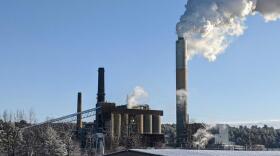A massive mobile weather station on the grounds of the University of Connecticut’s Storrs campus is seeking to unlock secrets stored in storm clouds.
Researchers at the school teamed up with NASA scientists over the winter to monitor snow, sleet and rain storms from the ground. Meanwhile, NASA flew planes over and into storm clouds to get a better picture of how precipitation changes as it falls.
The research project is called IMPACTS. It aims to improve storm prediction models to forecast how future snowstorms will affect our roads and power grid.
“The most immediate application is to really understand what type of snow is the [most] damaging,” said Diego Cerrai, an assistant professor at UConn.
Cerrai said that damage caused by severe weather is increasing and that slight temperature variations can mean the difference between light, fluffy snow and a more damaging wintry mix.
“When the temperature is just above freezing, you have the worst type of snow in terms of damages,” Cerrai said.
Within winter storms, snowfall is often organized into “banded structures that are poorly understood by scientists and poorly predicted by current numerical models,” according to NASA.
To better understand those bands, NASA recently used satellites and airplanes to monitor storm clouds from above. It also flew airplanes into snowstorms to gather real-time data.
Tracking snowfall from the ground
At UConn, Cerrai and other researchers tracked snowfall on the ground. Trailer-sized radar stations scanned the sky while high-speed cameras recorded the shape and density of individual falling snowflakes.

Cerrai gestured to a camera mounted opposite a floodlight that illuminates passing precipitation. Precisely tracking precipitation on the ground is crucial to improving weather models, he said.
“Through this mission, we are able to have better validation from the ground. And cross-validation between ground, satellites and airplanes,” Cerrai said.
He said snow density is directly related to precipitation rates.
“We need to understand how many particles are in a given volume of the atmosphere,” he said. “Those particles, in the end, will fall. And that will affect the precipitation rate that we have on the ground.”
Taking advantage of tech improvements
NASA said no major study of East Coast snowstorms has occurred over the last 30 years. Since then, Cerrai said, technology to do weather monitoring has vastly improved.
Gesturing to the weather station, Cerrai said the devices are connected to the internet, allowing for real-time collection of massive amounts of data.
“This is something that requires a lot of storage,” Cerrai said. “Acquiring 400 frames per second at very high resolution for a period of four months.”
“That is something that … just now is possible to do,” Cerrai said.

Even though this year has been a relatively light season for snow in Connecticut, Cerrai said, there have been mixed-precipitation events, which is providing key data for the project.
“This year, luckily, we had a lot of events that started with rain, ended with snow, or vice versa,” Cerrai said. “This is very important because we can measure the height … at which the snow that falls from the cloud is changing to rain.”
“We are able to classify the different snow types, the precipitation types,” Cerrai said. “All this is very important for improving the measurement of the different types of precipitation that we can have.”





